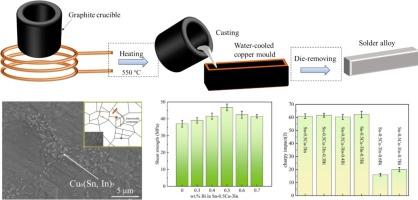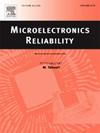Bi元素对Sn-Cu-In钎料合金组织、强度及失效机理的影响
IF 1.9
4区 工程技术
Q3 ENGINEERING, ELECTRICAL & ELECTRONIC
引用次数: 0
摘要
本文研究了添加0.3 ~ 0.7 wt% Bi后Sn-0.5Cu-3In钎料合金的显微组织、润湿性和力学性能的变化。在Sn-0.5Cu-3In钎料合金中添加Bi后,钎料合金的显微组织发生了变化,晶粒尺寸减小,均匀性提高。β-Sn相尺寸减小,金属间化合物分布更加致密。当Bi元素添加量小于0.5 wt%时,钎料合金的冲击性能变化不大,当Bi元素添加量为0.5 wt%时,冲击功达到最大62.2 J。焊点的剪切试验结果表明,添加Bi元素有效提高了焊点的可靠性,当添加0.5% wt%的Bi元素时,焊点的剪切强度达到了46.8 MPa的最大值。这是因为Bi与β-Sn形成固溶体,导致固溶体强化。Bi元素细化了钎料合金的晶粒,显著提高了焊点的抗剪强度。本文章由计算机程序翻译,如有差异,请以英文原文为准。

Effect of Bi element on microstructure, strength and failure mechanism of Sn-Cu-In solder alloy
In this paper, the changes of the microstructure, wettability, and mechanical properties, of the Sn-0.5Cu-3In solder alloy were studied after adding 0.3–0.7 wt% Bi. The addition of Bi to Sn-0.5Cu-3In solder alloy resulted in changes to the microstructure, with a decrease in grain size and an increase in uniformity. The β-Sn phase size also decreased, and the distribution of intermetallic compounds became denser. When the amount of Bi element added is less than 0.5 wt%, the impact performance of the solder alloy changes little, and the impact work reaches a maximum of 62.2 J when 0.5 wt% Bi is added. The shear test results of the solder joints show that the addition of Bi element effectively improves the reliability of the solder joints, and the shear strength reaches a maximum value of 46.8 MPa at the addition of 0.5 wt% of Bi element. This is because the Bi and β-Sn forms a solid solution, resulting in solid solution strengthening. And the Bi element refines the grains of the solder alloy, so the shear strength of the solder joint is significantly improved.
求助全文
通过发布文献求助,成功后即可免费获取论文全文。
去求助
来源期刊

Microelectronics Reliability
工程技术-工程:电子与电气
CiteScore
3.30
自引率
12.50%
发文量
342
审稿时长
68 days
期刊介绍:
Microelectronics Reliability, is dedicated to disseminating the latest research results and related information on the reliability of microelectronic devices, circuits and systems, from materials, process and manufacturing, to design, testing and operation. The coverage of the journal includes the following topics: measurement, understanding and analysis; evaluation and prediction; modelling and simulation; methodologies and mitigation. Papers which combine reliability with other important areas of microelectronics engineering, such as design, fabrication, integration, testing, and field operation will also be welcome, and practical papers reporting case studies in the field and specific application domains are particularly encouraged.
Most accepted papers will be published as Research Papers, describing significant advances and completed work. Papers reviewing important developing topics of general interest may be accepted for publication as Review Papers. Urgent communications of a more preliminary nature and short reports on completed practical work of current interest may be considered for publication as Research Notes. All contributions are subject to peer review by leading experts in the field.
 求助内容:
求助内容: 应助结果提醒方式:
应助结果提醒方式:


